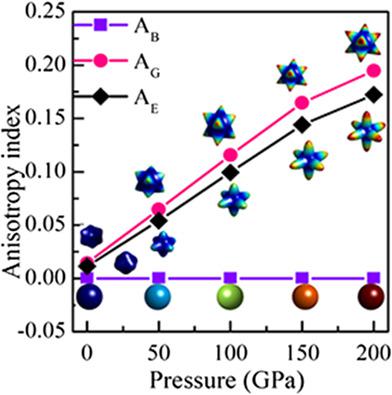当前位置:
X-MOL 学术
›
Int. J. Quantum Chem.
›
论文详情
Our official English website, www.x-mol.net, welcomes your
feedback! (Note: you will need to create a separate account there.)
Mechanical behavior of high entropy carbide (HfTaZrTi)C and (HfTaZrNb)C under high pressure: Ab initio study
International Journal of Quantum Chemistry ( IF 2.3 ) Pub Date : 2020-10-17 , DOI: 10.1002/qua.26509 Shan Jiang 1 , Lin Shao 1 , Touwen Fan 2 , Jia‐Ming Duan 1 , Xiao‐Tao Chen 1 , Bi‐Yu Tang 1
International Journal of Quantum Chemistry ( IF 2.3 ) Pub Date : 2020-10-17 , DOI: 10.1002/qua.26509 Shan Jiang 1 , Lin Shao 1 , Touwen Fan 2 , Jia‐Ming Duan 1 , Xiao‐Tao Chen 1 , Bi‐Yu Tang 1
Affiliation

|
The evolution of structural, elastic, and electronic properties of high entropy carbide (HfTaZrTi)C and (HfTaZrNb)C under high pressure have been studied within the framework of density functional theory (DFT) in conjunction with special quasirandom structures. With increasing pressure, lattice constants of high entropy carbides (HfTaZrTi)C and (HfTaZrNb)C gradually decrease, so volumes shrink, and densities gradually increase. Under high pressure up to 200 GPa, elastic stiffness coefficients for both carbides are almost linearly hardened and meet the elastic stability criteria. With increasing pressure, elastic moduli and Debye temperature of both high entropy carbides (HfTaZrTi)C and (HfTaZrNb)C increase, while theoretical Vickers hardness decreases, although Vickers hardness of (HfTaZrNb)C is always higher than (HfTaZrTi)C in the whole pressure. The ductility of (HfTaZrTi)C and (HfTaZrNb)C is improved under pressure, and brittle‐ductile transition occurs at about 50 and 60 GPa, respectively. The electronic structure demonstrates that, with increasing pressure, covalent bonds between transition metal atoms and carbon atoms are strengthened, accompanying delocalization. This effect is responsible for high values of bulk modulus and shear modulus under pressure and enhanced ductility. The ionic bonds of both high entropy carbides weaken with increasing pressure, and (HfTaZrTi)C is affected more strongly by the pressure.
中文翻译:

高熵碳化物(HfTaZrTi)C和(HfTaZrNb)C在高压下的力学行为:从头算研究
在密度泛函理论(DFT)的框架下,结合特殊的拟随机结构,研究了高熵碳化物(HfTaZrTi)C和(HfTaZrNb)C在高压下的结构,弹性和电子性质的演变。随着压力的增加,高熵碳化物(HfTaZrTi)C和(HfTaZrNb)C的晶格常数逐渐降低,因此体积缩小,密度逐渐增加。在高达200 GPa的高压下,两种碳化物的弹性刚度系数几乎都进行了线性硬化,并符合弹性稳定性标准。随着压力的增加,高熵碳化物(HfTaZrNb)C和(HfTaZrNb)C的弹性模量和德拜温度均增加,而理论上的维氏硬度下降,尽管(HfTaZrNb)C的维氏硬度总体上始终高于(HfTaZrTi)C压力。在压力下,(HfTaZrTi)C和(HfTaZrNb)C的延展性得到了改善,脆性-延性转变分别在50 GPa和60 GPa时发生。电子结构表明,随着压力的增加,过渡金属原子和碳原子之间的共价键增强,并伴随着离域作用。这种作用导致在压力下具有较高的体积模量和剪切模量值,并增强了延展性。两种高熵碳化物的离子键都随着压力的增加而减弱,并且(HfTaZrTi)C受压力影响更大。伴随着离域作用,过渡金属原子和碳原子之间的共价键得到加强。这种作用导致在压力下具有较高的体积模量和剪切模量值,并增强了延展性。两种高熵碳化物的离子键都随着压力的增加而减弱,并且(HfTaZrTi)C受压力影响更大。伴随着离域作用,过渡金属原子和碳原子之间的共价键得到加强。这种作用导致在压力下具有较高的体积模量和剪切模量值,并增强了延展性。两种高熵碳化物的离子键都随着压力的增加而减弱,并且(HfTaZrTi)C受压力影响更大。
更新日期:2020-10-17
中文翻译:

高熵碳化物(HfTaZrTi)C和(HfTaZrNb)C在高压下的力学行为:从头算研究
在密度泛函理论(DFT)的框架下,结合特殊的拟随机结构,研究了高熵碳化物(HfTaZrTi)C和(HfTaZrNb)C在高压下的结构,弹性和电子性质的演变。随着压力的增加,高熵碳化物(HfTaZrTi)C和(HfTaZrNb)C的晶格常数逐渐降低,因此体积缩小,密度逐渐增加。在高达200 GPa的高压下,两种碳化物的弹性刚度系数几乎都进行了线性硬化,并符合弹性稳定性标准。随着压力的增加,高熵碳化物(HfTaZrNb)C和(HfTaZrNb)C的弹性模量和德拜温度均增加,而理论上的维氏硬度下降,尽管(HfTaZrNb)C的维氏硬度总体上始终高于(HfTaZrTi)C压力。在压力下,(HfTaZrTi)C和(HfTaZrNb)C的延展性得到了改善,脆性-延性转变分别在50 GPa和60 GPa时发生。电子结构表明,随着压力的增加,过渡金属原子和碳原子之间的共价键增强,并伴随着离域作用。这种作用导致在压力下具有较高的体积模量和剪切模量值,并增强了延展性。两种高熵碳化物的离子键都随着压力的增加而减弱,并且(HfTaZrTi)C受压力影响更大。伴随着离域作用,过渡金属原子和碳原子之间的共价键得到加强。这种作用导致在压力下具有较高的体积模量和剪切模量值,并增强了延展性。两种高熵碳化物的离子键都随着压力的增加而减弱,并且(HfTaZrTi)C受压力影响更大。伴随着离域作用,过渡金属原子和碳原子之间的共价键得到加强。这种作用导致在压力下具有较高的体积模量和剪切模量值,并增强了延展性。两种高熵碳化物的离子键都随着压力的增加而减弱,并且(HfTaZrTi)C受压力影响更大。











































 京公网安备 11010802027423号
京公网安备 11010802027423号